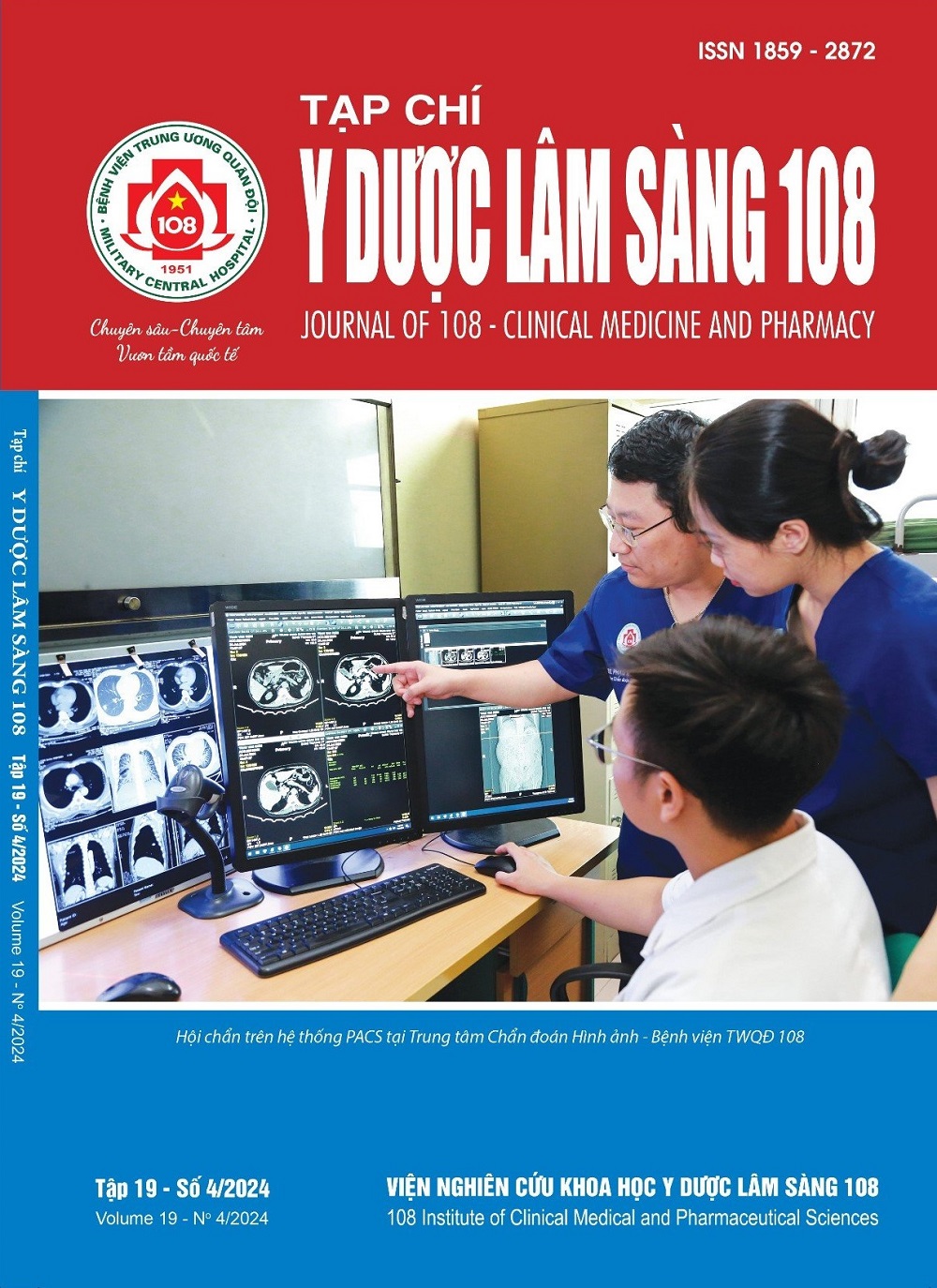Giá trị của L-FABP niệu trong dự đoán tổn thương thận cấp ở bệnh nhân nhiễm khuẩn huyết và sốc nhiễm khuẩn
Main Article Content
Keywords
Tóm tắt
Mục tiêu: Đánh giá giá trị của L-FABP niệu trong dự đoán tổn thương thận cấp (acute kidney injury - AKI) ở bệnh nhân nhiễm khuẩn huyết và sốc nhiễm khuẩn. Đối tượng và phương pháp: Nghiên cứu mô tả tiến cứu trên 201 bệnh nhân nhiễm khuẩn huyết và sốc nhiễm khuẩn tại Bệnh viện TƯQĐ 108. Kết quả: Nồng độ L-FABP niệu ở nhóm có AKI là 56,97 ± 12,49µg/g Creatinin (Cre), cao hơn nhóm không AKI (6,37 ± 3,61 µg/g Cre), p<0,05. Nồng độ L-FABP niệu ở nhóm sốc nhiễm khuẩn (43,03 ± 10,57µg/g Cre) cao hơn ở nhóm nhiễm khuẩn huyết (28,92 ± 9,94µg/g Cre), p<0,05. Nồng độ L-FABP niệu tại thời điểm nhập cấp cứu có giá trị dự đoán AKI xuất hiện ở ngày thứ 2 và thứ 3 sau nhập viện, với AUC = 0,796 và AUC = 0,732; p<0,05. Kết luận: Nồng độ L-FABP niệu ở nhóm có AKI cao hơn hẳn nhóm không AKI và sử dụng L-FABP niệu tại thời điểm bệnh nhân nhập cấp cứu có giá trị dự đoán AKI xuất hiện ở ngày thứ 2 và thứ 3 sau nhập viện. Tại điểm cắt L-FABP = 12,26µg/g Cre có giá trị tiên đoán AKI chung với độ nhạy 87,7%, độ đặc hiệu 87,3%.
Article Details
Các tài liệu tham khảo
2. Hiruma T, Asada T, Yamamoto M, Inokuchi R, Matsubara T, Ishii T, Sumida M, Isshiki R, Mayumi K, Noiri E, Nangaku M, Yahagi N, Doi K (2014) Mortality prediction by acute kidney injury biomarkers in comparison with serum creatinine. Biomarkers 19(8): 646-451.
3. Coca SG, Nadkarni GN, Garg AX, Koyner J, Thiessen-Philbrook H, McArthur E, Shlipak MG, Parikh CR; TRIBE-AKI Consortium (2016) First post-operative urinary kidney injury biomarkers and association with the duration of AKI in the TRIBE-AKI cohort. PLoS One 11(8): 0161098.
4. Greenberg JH, Zappitelli M, and Jia Y (2018) Biomarkers of AKI progression after pediatric cardiac surgery. J Am Soc Nephrol 29(5):1549-1556. doi: 10.1681/ASN.2017090989.
5. Parikh CR, Puthumana J, Shlipak MG, Koyner JL, Thiessen-Philbrook H, McArthur E, Kerr K, Kavsak P, Whitlock RP, Garg AX, Coca SG (2017) Relationship of kidney injury biomarkers with long-term cardiovascular outcomes after cardiac surgery. J Am Soc Nephrol 28(12): 3699-3707.
6. Rhodes A (2017) Surviving sepsis campaign: International guidelines for management of sepsis and septic shock: 2016. Crit Care Med 45: 486-552.
7. KDIGO (2012) KDIGO clinical practice guideline for acute kidney injury. Kidney International Supplements, vol 2 supplement.
8. Negishi K, Noiri E, Doi K, Maeda-Mamiya R, Sugaya T, Portilla D, Fujita T (2009) Monitoring of urinary L-type fatty acid-binding protein predicts histological severity of acute kidney injury. Am J Pathol 174(4): 1154-1159.
9. Doi K, Noiri E, and Sugaya T (2010) Urinary L-type fatty acid-binding protein as a new renal biomarker in critical care. Curr Opin Crit Care 16(6): 545-549.
10. Nakamura T, Sugaya T, and Koide H (2009) Urinary liver-type fatty acid-binding protein in septic shock: effect of polymyxin B-immobilized fiber hemoperfusion. Shock 31(5): 454-459.
11. Ferguson MA, Vaidya VS, Waikar SS, Collings FB, Sunderland KE, Gioules CJ, Bonventre JV (2010) Urinary liver-type fatty acid-binding protein predicts adverse outcomes in acute kidney injury. Kidney Int 77(8): 708-714.
12. Cho E, Yang HN, Jo SK, Cho WY, Kim HK (2013) The role of urinary liver-type fatty acid-binding protein in critically ill patients. J Korean Med Sci 28(1): 100-105.
13. Yoshimatsu S, Sugaya T, Hossain MI, Islam MM, Chisti MJ, Kamoda T, Fukushima T, Wagatsuma Y, Sumazaki R, Ahmed T (2016) Urinary L-FABP as a mortality predictor in < 5-year-old children with sepsis in Bangladesh. Pediatr Int 58(3): 185-191.
14. Youness ER (2018) Urinary NGAL and L-FABP as valuable biomarkers for early detection of acute kidney injury in intensive care unit patients. ARC Journal of Nephrology 3(1): 19-28.
15. Suzuki G, Ichibayashi R, Yamamoto S, Nakamichi Y, Watanabe M, Honda M (2019) Clinical significance of urinary L-FABP in the emergency department. Int J Emerg Med 12(1): 24.
 ISSN: 1859 - 2872
ISSN: 1859 - 2872
